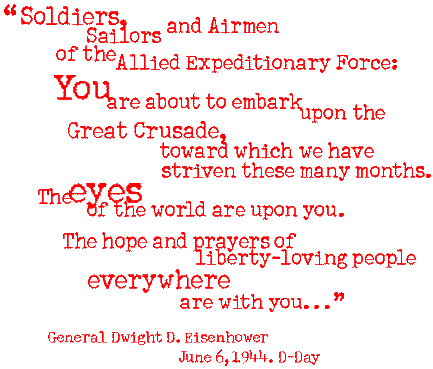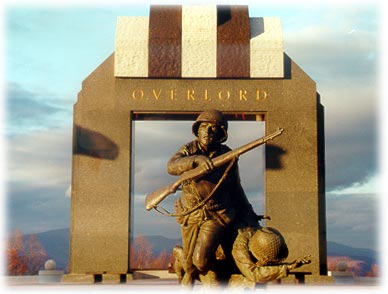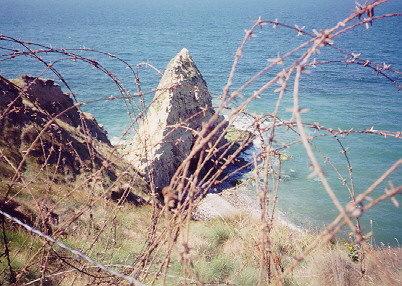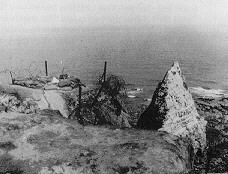

Fact Sheet D-Day, 6 June 1944 Normandy, France
Prelude to Operation OverlordDuring the first six months of 1944, the United States and Great Britain concentrated land, naval, and air forces in England to prepare for Operation Overlord, the assault on Hitler's "Fortress Europe." While the Soviet Union tied down a great portion of the enemy's forces, the western Allies marshaled their resources, trained their forces, separately and jointly, for the operation, and fine tuned the invasion plans to take full advantage of their joint and combined capabilities.Before the invasion, the air and sea components played major roles. The 12,000 planes of the Allied air forces swept the Luftwaffe from the skies, photographed enemy defenses, dropped supplies to the resistance, bombed railways, attacked Germany's industries and isolated the battlefield. The Allies' naval component was similarly active during the buildup. The navies escorted convoys, patrolled and protected the English Channel, reconnoitered beaches and beach defenses, conducted amphibious rehearsals and organized and loaded a mighty flotilla to land the assault forces in France. Meanwhile, the nine army divisions (three airborne and six infantry) from the United States, Britain and Canada trained and rehearsed their roles in the carefully choreographed operation. Rangers climbed cliffs, engineers destroyed beach obstacles, quartermasters stockpiled supplies and infantrymen waded through the English surf as each honed the skills necessary for the invasion's success.
Normandy InvasionSupreme Commander--General Dwight D. EisenhowerAllied Expeditionary Naval Forces--Admiral Sir Bertram Ramsay 21st Army Group--General Sir Bernard L. Montgomery Allied Expeditionary Air Forces--Air Marshal Sir Trafford Leigh- Mallory
United States Army United Kingdom Land Forces First Army Second British Army V Corps 1st British Corps VII Corps 30th British Corps 1st Infantry Division 3rd British Infantry Division 4th Infantry Division 6th British Airborne Division 29th Infantry Division 50th British Infantry Division 82nd Airborne Division 3rd Canadian Infantry Division 101st Airborne Division Air Forces U.S. Army Air Forces Royal Air Forces Eighth Air Force 2nd Tactical Air Force Ninth Air Force Allied Expeditionary Naval Forces Western Task Force Eastern Task Force (United States) (British) D-Day OperationsThe invasion itself gave prominence to land forces but provided major roles for air and sea components. Allied air forces carried three airborne divisions into battle, protected the force as it crossed the English Channel, and attacked targets throughout the invasion area before and after the landing in support of the assault forces. More than 5,000 ships--from battleships to landing craft--carried, escorted and landed the assault force along the Normandy coast. Once the force was landed, naval gunfire provided critical support for the soldiers as they fought their way across the beaches.In the invasion's early hours, more than 1,000 transports dropped paratroopers to secure the flanks and beach exits of the assault area. Amphibious craft landed some 130,000 troops on five beaches along 50 miles of Normandy coast between the Cotentin Peninsula and the Orne River while the air forces controlled the skies overhead. In the eastern zone, the British and Canadians landed on GOLD, JUNO and SWORD Beaches. The Americans landed on two beaches in the west--UTAH and OMAHA. As the Allies came ashore, they took the first steps on the final road to victory in Europe.
Omaha Beach
The landing by regiments of the 1st and 29th Infantry divisions and Army Rangers on OMAHA Beach was even more difficult than expected. When the first wave landed at 6:30 a.m., the men found that naval gunfire and pre-landing air bombardments had not softened German defenses or resistance. Along the 7,000 yards of Normandy shore German defenses were as close to that of an Atlantic Wall as any of the D-Day beaches. Enemy positions that looked down from bluffs as high as 170 feet, and water and beach obstacles strewn across the narrow strip of beach, stopped the assault at the water's edge for much of the morning of D-Day. By mid-morning, initial reports painted such a bleak portrait of beachhead conditions that Lt. Gen. Omar Bradley, United States First Army commander, considered pulling off the beach and landing troops elsewhere along the coast. However, during these dark hours, bravery and initiative came to the fore. As soldiers struggled, one leader told his men that two types of people would stay on the beach--the dead and those going to die--so they'd better get the hell out of there, and they did. Slowly, as individuals and then in groups, soldiers began to cross the fire-swept beach. Supported by Allied naval gunfire from destroyers steaming dangerously close to shore, the American infantrymen gained the heights and beach exits and drove the enemy inland. By day's end V Corps had a tenuous toehold on the Normandy coast, and the force consolidated to protect its gains and prepare for the next step on the road to Germany.
Utah BeachIn the predawn darkness of June 6, the 82nd and 101st Airborne Divisions were air dropped behind UTAH Beach to secure four causeways across a flooded area directly behind the beach and to protect the invasion's western flank. Numerous factors caused the paratroopers to miss their drop zones and become scattered across the Norman countryside. However, throughout the night and into the day the airborne troops gathered and organized themselves and went on to accomplish their missions. Ironically, the paratroopers' wide dispersion benefited the invasion. With paratroopers in so many places, the Germans never developed adequate responses to the airborne and amphibious assaults.The 4th Infantry Division was assigned to take UTAH Beach. In contrast with OMAHA Beach, the 4th Division's landing went smoothly. The first wave landed 2,000 yards south of the planned beach--one of the Allies' more fortuitous opportunities on D-Day. The original beach was heavily defended in comparison to the light resistance and few fixed defenses encountered on the new beach. After a personal reconnaissance, Brigadier General Theodore Roosevelt Jr., who accompanied the first wave, decided to exploit the opportunity and altered the original plan. He ordered that landing craft carrying the successive assault waves land reinforcements, equipment and supplies to capitalize on the first wave's success. Within hours, the beachhead was secured and the 4th Division started inland to contact the airborne divisions scattered across its front. As in the OMAHA zone, at day's end the UTAH Beach forces had not gained all of their planned objectives. However, a lodgement was secured, and, most important, once again the American soldier's resourcefulness and initiative had rescued the operation from floundering along the Normandy coast.
Sources
|
June 6, 1944
changed the course of modern history.
Yet in the United States, there had been
no national memorial to D-Day
until June 6, 2001.

Byron Dickson & Associates,
Architect
Principal Sculptor, Jim Brothers
Sculptor, Matt Kirby
D-Day:
It is hard to conceive the epic scope of this decisive battle that
foreshadowed the end of Hitler's dream of Nazi domination. Overlord was the
largest air, land, and sea operation undertaken before or since June 6, 1944.
The landing included over 5,000 ships, 10,000 airplanes, and 150,000 service men
and women.
After years of meticulous planning and seemingly endless training, for the Allied Forces, it all came down to this: The boat ramp goes down, then jump, swim, run, and crawl to the cliffs. Many of the first young men (most not yet 20 years old) entered the surf carrying eighty pounds of equipment. They faced over 200 yards of beach before reaching the first natural feature offering any protection. Blanketed by small-arms fire and bracketed by artillery, they found themselves in hell.
When it was over, the Allied Forces had suffered nearly 10,000 casualties;
more than 4,000 were dead. Yet somehow, due to planning and preparation, and due
to the valor, fidelity, and sacrifice of the Allied Forces, Fortress Europe had
been breached.
The terms D-Day and H-Hour are used for the day and hour on which a combat attack or operation is to be initiated. They designate day and hour for an operation when the actual day and hour have not yet been determined or announced. The letters are derived from the words for which they stand, "D" for the day of the invasion and "H" for the hour the operation actually begins.
When used in combination with figures and plus or minus signs, these terms indicate the length of time preceding or following a specific action. Thus, H-3 means 3 hours before H-hour, and D+3 means 3 days after D-day. H+75 minutes means H-hour plus 1 hour and 15 minutes.
Planning papers for large-scale operations are made up in detail long before, specific dates are set. Phased orders are planned for execution on D-Day or H-Hour minus or plus a certain number of days, hours, or minutes.
According to the U.S. Army's Center of Military History, the earliest known use of these terms is in Field Order Number 9, First Army, American Expeditionary Forces. It is dated September 7, 1918: "The first Army will attack at H hour on D day with the object of forcing the evacuation of the St. Mihiel Salient."
D-Day for the invasion of Normandy was set for June 5, 1944, but it actually
occurred on June 6. Therefore, D-Day, as it applies to Overlord, is June 6,
1944.
Source: The General Service Schools, Fort Leavenworth, Kansas,
Combat Orders
(Fort Leavenworth, Kansas: The General Service Schools Press,
1922).
|
D-Day Glossary: Allied Expeditionary Force (AEF): The Allied force under the
command of General Dwight D. Eisenhower. Twelve nations supplied
troops and matèriel for the AEF: United States, Australia, Belgium,
Canada, Czechoslovakia, France, Greece, Netherlands, New Zealand,
Norway, Poland, and the United Kingdom. |

Point Du Hoc Today

Point Du Hoc YesterYear
D-Day Participant Identification and Profile
Project.
A data base is currently being created to collect the
names of those who participated in Operation Overlord and Operation Neptune on
June 6, 1944, the initial day of the Normandy Invasion. This includes those who
participated in D-Day but died after June 6 and before the end of the war, those
who died since the end of the war, and those who are still living.
If you were a participant in the D-Day Invasion of Normandy, or if you had a
family member or friend who was a participant, please contact:
National D-Day Memorial Foundation
Attention: Carol Tuckwiller
202 East Main Street, P.O. Box 77
Bedford, Va. 24523
(540) 586-DDAY
(800) 351-DDAY
Fax: (540) 586-7200
Click
here for more information on the Fourth of July, the Magna Carta, the
Mayflower Compact, the Emancipation Proclamation, the Bill of Rights, care of
our Flag and more.
Copyright ©Emotions Greeting Cards a division of VH Productions 2000-2002